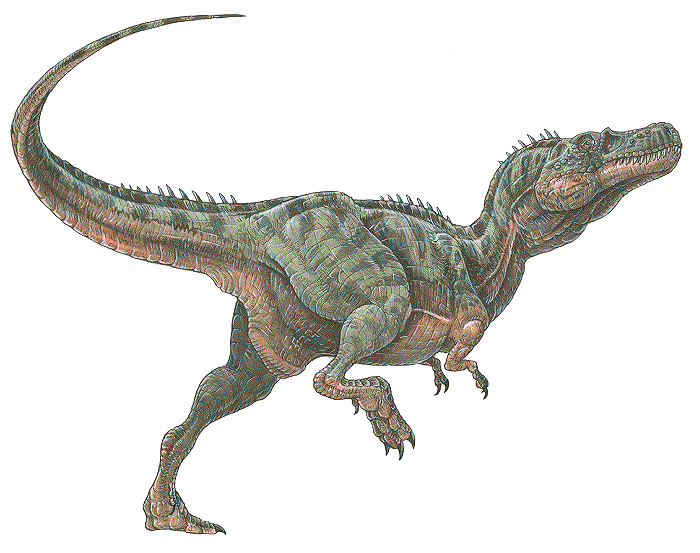
Xu Xing, a Chinese paleontologist, puzzled over the thigh bone of a monstrous new dinosaur he and his partners had discovered in the rich fossil beds of the Gobi Desert.
The bone was so big, he said in an e-mail to The Chronicle, that he thought he and his colleagues had merely found another of those familiar plant-eating, long-necked, semi-aquatic creatures called sauropods, well known in the evolutionary past of the dinosaur world.
Then he thought the bone most likely had come from a tyrannosaur -- perhaps the voracious and towering T. rex, the prime predator of fright movies.
But no, it wasn't T. rex at all; it was a fossil from the largest birdlike creature ever seen, Xu said. More than 26 feet long and 16 1/2 feet tall, it was a young adult that must have weighed at least a ton and a half when it was alive more than 70 million years ago, he said. It thrived in the late Cretaceous period only a few million years before all the dinosaurs on Earth became extinct.
"When I went back to my geologist colleague Lin Tan's lab to check the skeleton, I was shocked," Xu wrote in his e-mail. "I said to Tan, 'It is not a sauropod, it is not a tyrannosaurus, it is a tyrannosaurus-sized oviraptor. We have a gigantic chicken!' "
And that's the report the journal Nature is publishing today: the discovery of a creature Xu's team has named Gigantoraptor erlianensis, a giant birdlike dinosaur from the Gobi's Erlian basin, long known to science for its famous fossils and to prospectors for its vast oil reserves.
From the fossil record, the world's leading paleontologists are now sure that all modern birds are descended from the dinosaurs; in fact, the scientists often term birds "modern dinosaurs." And paleontologists, studying the fossils marking the evolution of birds during the age of dinosaurs, have observed that as the birdlike dinosaurs approached birdness, they seem to have evolved into smaller and smaller types.
So what's an enormous beast like Gigantoraptor doing among the avian world's ancestors?
It's a curious twist in the long up-and-down saga of evolution that has intrigued science ever since the Cambrian explosion of 500 million years ago, when the ancestors of countless familiar life forms emerged -- in the short span of 10 million years.
Said UC Berkeley's Kevin Padian, a leading expert on dinosaur evolution and curator of the university's Museum of Paleontology who has seen the report from Xu and Tan:
"We have dwarf sauropods, so why not giant oviraptors (the term means 'egg thief')? If resources are available, all animals will take the opportunity to increase their size. Dinosaurs can get small, and dinosaurs can get big, and the bigger ones grow faster than the little ones, because getting bigger fast can reduce the number of predators around.
"It all goes to show that when it comes to the diversity of dinosaurs, we're still just scratching the surface."
The details in the report by Xu and Tan are fascinating: "Growth lines" in one bone showed that the creature grew to adult size in only seven years -- faster than most other two-footed, meat-eating dinosaurs and "probably died in the eleventh year of life."
The animal had no teeth in its beak so its diet is a mystery, Xu said, because it had the relatively small head and long neck typical of plant-eaters, and the sharp claws of many meat-eaters.
And while the fossil-hunters found no evidence of feathers -- as many dinosaur species show -- the beast could well have had feathered arms and feathers on its tail, most likely for sexual display.
Finally, although most two-footed dinosaurs had stout legs to carry their weight, and short arms, Gigantoraptor's legs were relatively long and slender, and its arms were unusually long -- "more birdlike than its small relatives in many features," Xu said.
Mark Norell at the American Museum of Natural History has hunted dinosaur fossils with Xu in the Gobi Desert in the past but was not involved in this discovery. He studied the Gigantoraptor's fossil bones last year at Xu's Institute of Paleontology and Paleoanthropology in Beijing.
"It was really a surprise when I first saw it," Norell said in a telephone conversation. As dinosaurs evolved toward birds, they got smaller and smaller, their fossils show; until now, birdlike dinosaurs were at most 10 or 11 feet long -- certainly not 26 feet.
Paul Sereno, a paleontologist at the University of Chicago who read the report, called it "a big find, really exciting -- a class act."
"But what kind of environment on Earth was this animal adapted to?" he wondered. "It's off the charts, and with no teeth what did it eat? Did it use those long legs to escape from predators? It's clearly a pre-flight bird, but no one would have predicted its evolution, so the door seems open to a new way of living for a new kind of dinosaur."
E-mail David Perlman at
dperlman@sfchronicle.com.
This article appeared on page A - 7 of the San Francisco Chronicle
Fausto Intillawww.oloscience.com
























